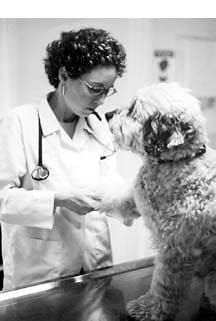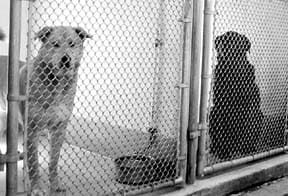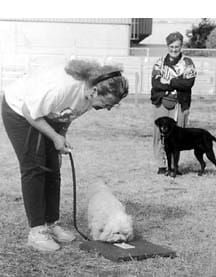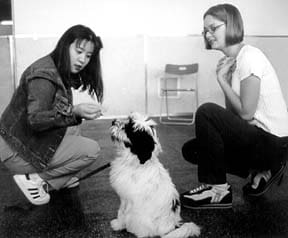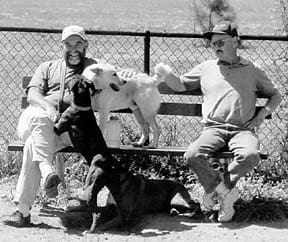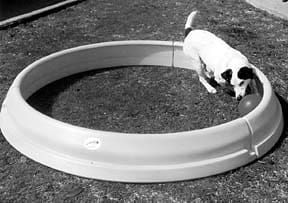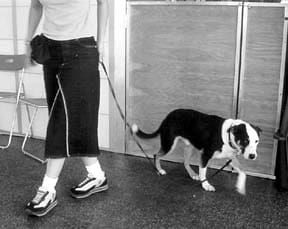Let’s face it: Most dogs aren’t crazy about going to the vet. And why should they be? After all, vet visits are stressful at best. They often mean a new environment, slippery floors, and even more slippery exam tables. Vet offices are full of funny smells, scary sounds, strange people, and unknown animals. Plus, the poking and prodding they are subjected to can be uncomfortable and sometimes even painful. It may be overwhelming for even the most easygoing dog.
Reasoning with your dog may help some (“Oh, honey, it’s for your own good!”). But what will help even more is getting your dog accustomed to the types of experiences that he is likely to encounter on visits to the veterinarian. The following seven tips can help you help your dog learn to tolerate the occasional “well-dog” health examanination. They will also help your dog be better prepared to accept necessary medical treatment in case of a serious illness or injury.
1. Take your dog by the vet’s office, just to say hello.
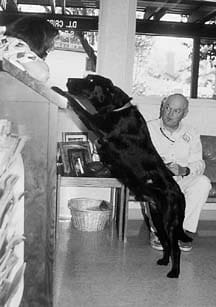
“One of the best things you can do,” says E.V. Sharp, DVM, of Creekside Veterinary Hospital in Soquel, California, “is just to stop by every once in a while. Bring your dog in, weigh him, and walk out again.” New places are sometimes anxiety producing – just because they are new. Stopping by occasionally reduces your dog’s anxiety by simply transforming the vet’s office from an unknown to a known environment.
Better yet, take along some great treats, preferably something that is incredibly special to your dog like steak or hot dogs. Ask the receptionist, the vet tech, and even your veterinarian to give your dog a few treats, too. If you have a puppy, start your “social” vet visits as early as possible. But don’t worry if you have an older dog or a dog that is already anxious about vet visits. Fun and happy social visits can dramatically reduce an adult dog’s stress level too.
Be sure to call ahead and tell your vet what you want to do. Ask if there is a good time to stop by for a few minutes. You’ll want to make sure that your social visit is convenient for the vet and the office staff. You’ll also want to make sure they are not dealing with an emergency or an infectious disease at the time of your visit.
2. Take the time to touch your dog everywhere, every day!
Getting your dog accustomed to being touched all over is essential for your dog’s comfort during an examination. In a routine exam, a veterinarian may look in your dog’s eyes, ears, and mouth, listen to his heart and lungs, touch and probe his belly, manipulate his joints, and take his temperature. Dogs that are handled, petted, and touched all over daily will be less likely to perceive this as invasive, and more likely to regard it as affectionate (if somewhat personal!) touching.
In addition, when you regularly spend time touching your dog, you will be more likely to notice changes such as lumps, swelling, or tenderness that may indicate health problems.
One great way to help your dog learn to tolerate being handled is to make it part of play and relaxation. When you play rowdy games such as fetch, wrestle, or tug-o-war with your dog, you can encourage the game and help your dog tolerate touch through play pats, ruffling his fur, and gentle roughhousing. When you spend quiet time with your dog, stroke and pet him all over. Play with your dog’s ears, muzzle, belly, and around his tail. Try holding your dog’s paw while you rub his tummy. Massage his shoulders and hips. Stroke your dog’s ears and gently place your finger inside the ears. Touch around his legs and in between his toes.
“It’s also a good idea to pinch them every once in a while,” said Dr. Sharp. Not hard of course, but enough that a little needle pinch for vaccinations or drawing blood won’t be a totally unusual experience.
Another very important part of this routine is to take note of your dog’s sensitive spots. Most dogs have one or more spots where they prefer not to be touched. Some dogs don’t like to have their paws touched. Others may not like their hips, ears, or tails touched.
You can help even the most reluctant dog accept the handling of sensitive areas with a little patience and some great treats. Have your dog near you in a comfortable position. Then feed your dog his favorite treats while briefly touching the sensitive spot. For example, if your dog is sensitive about having his paws handled, gently and quickly stroke your dog’s paw and then give him a slice of hot dog or another great treat. Once your dog is happy about the brief touch (because he knows the hot dog is coming!), you can leave your hand on his paw just a little bit longer before giving him the treat. Gradually work up to holding the paw, then giving gentle squeezes, and eventually touching between his toes. (For more details on this technique, see “Classical Conditioning,” WDJ June 2001.)
Don’t try to rush it or push your dog to do anything that is uncomfortable. The goal is to help your dog learn to accept or even enjoy being touched everywhere. If your dog exhibits any aggression around being touched, please consult with a behaviorist to help you work through the problem.
When your dog is happy about being touched all over, ask friends, a trainer, or other family members to touch your dog, too. The more dogs are accustomed to being handled by different people, the easier it will be for them to be handled during regular vet visits or in the case of an illness.
Remember being a kid and wanting to dress your animals up? That can actually help, too! “If your dog enjoys it, put things on them,” Dr. Sharp said, laughing at the idea. Bandanas, doggie sweaters, booties, dog packs, and other items can help your dog accept things like bandages or Elizabethan collars if the need ever arises.
3. Play with your dog’s mouth.
“Probably the hardest thing we deal with regularly are dogs who are not used to having their mouths handled,” says Dr. Sharp. She recommends brushing your dog’s teeth regularly to help them get used to having their mouths handled. “It really pays off! It’s good for the dog and the vet. It can extend times between teeth cleanings, too.” With some dogs, Dr. Sharp notes, it can even mean the difference between being able to perform teeth cleanings with the dog awake and having to give the dog anesthesia.
In Dr. Sharp’s opinion, it’s not as important to brush the teeth really well as it is just to do it! Even brushing the outsides of the teeth can make a big difference. Always use canine toothpaste; people toothpaste isn’t safe for dogs. Plus, the great flavors available in doggy toothpaste, such as chicken, beef, or malt, can make brushing all the more enjoyable for your dog.
Another good exercise is opening your dog’s mouth, looking in, and then immediately popping a treat in his mouth. Your dog will learn that your opening his mouth means treats are coming.
Dogs can also learn to enjoy having their mouths’ handled if you dab a little peanut butter, yogurt, or cottage cheese on your finger and then rub your finger over your dog’s gums or along the roof of his mouth. Your dog will get used to having fingers in his mouth, plus he’ll get a special taste treat.
4. Get your dog used to being leaned over, held onto, and picked up.
Even dogs that are handled regularly can have a tough time when someone leans over them, holds them down, or picks them up – understandably so! But during routine vet visits and especially during an emergency, your dog may need to be lifted onto a table, the veterinarian will need to lean over your dog, and your dog may need to be held for vaccines or exams as well as for emergency procedures.
Bending over your dog from various positions in play and other activities can help him learn to accept this behavior from humans. In addition, you can help your dog tolerate being held through everyday affectionate behaviors. For example, if your dog enjoys a good belly rub, try reaching over your dog’s shoulder to rub his belly. In our home, for example, we routinely kiss the tops of our dogs’ heads, reach around their shoulders to rub their tummies, and give them great big gentle bear hugs. All of these activities are fun, and help our dogs accept and even enjoy being leaned over and held onto (plus we get lots of dog kisses in return!).
Smaller dogs are more often used to being carried, but for some larger dogs, the only time they are physically picked up is at the vet’s office. That in and of itself can be a traumatic experience. You can set up specific training times to familiarize your dog with being lifted, or you can incorporate this into regular activities. When you groom your dog, for example, consider lifting him on to a low table. If you are not sure how to lift your dog properly (for your safety and his), ask your veterinarian, groomer, or trainer to show you how to easily and safely pick up your dog.
5. Teach your dog to sit, stand, lie down, and turn around.
Basic training can really help lower your dog’s stress at the veterinary clinic. Your dog will be a whole lot more relaxed if you can ask him to move his own body, rather than having to push, pull, or cajole your dog into position.
The basic behaviors that are essential for ease during vet exams include:
• Sit and down. Because many dogs want to flop over or slink away instead of holding still, knowing sit and down can make it easier on both your dog and the vet during an exam.
• Relax. Also known as “roll on your side,” this trick is great for positioning dogs when the vet needs to scrutinize just one side of your dog.
• Stand. This is another basic position that is good for specific exams. Plus, it’s easier to pick your dog up from a stand if you need to lift him onto the table.
• Turn. Veterinarians often want to turn your dog so that he is facing a different direction on the table. Instead of having to physically move your dog, a simple turn behavior (carefully if they are up on a table) can eliminate the need for having to physically manipulate them into position.
A few other behaviors that may also be helpful include:
• “Touch” or “Target.” If your dog is trained to touch your hand with his nose on cue (see “Right on Target,” WDJ March 2001), then you can use a hand touch to help move or position your dog, or to move his head up or down. It may also be useful in helping dogs if they need to be given nose drops!
• Shake. Also called “give me a paw,” this exercise can help turn foot examinations into a fun activity for your dog!
• Watch me. Any type of eye contact exercise is a good tool to turn his head in a particular direction, but also this is a great exercise to keep your dog occupied while being examined.
6. Familiarize your dog with a muzzle and crate, just in case!
Getting your dog used to wearing a soft muzzle doesn’t mean your dog is bad, or that he will necessarily bite. For some dogs, using a muzzle is a good way to ensure safety if the vet needs to examine a sensitive place. And, even sweet, gentle, and well-socialized dogs can bite when they are threatened, scared, or hurt; it’s an instinctive and normal reaction. Plus, a dog that is seriously ill or has suffered a painful injury may lash out without even realizing what he is doing.
Purchasing a soft muzzle (the fabric kind with an opening on the end that allows your dog to take treats while wearing) and helping your dog learn to wear it comfortably can become a fun game – and it will ensure that your dog is prepared, just in case.
To help your dog learn to wear a muzzle, simply hold a treat on the “nose” part of the muzzle. Let your dog put his nose through and take the treat. Have your dog do this several times every day for a week or more. When your dog becomes excited when he sees the muzzle (because he knows it means treats), you can slip it on for a few seconds, feed your dog a treat or two, and then take it right back off. After a week or more at this stage, you can start leaving it on for a few seconds at a time and gradually increase the time. Keep this game fun!
Once your dog can comfortably wear the muzzle for a few minutes at a time, you can put it away and bring it out occasionally to remind your dog how much fun the muzzle is to wear. Then, if your dog ever needs to wear a muzzle during an emergency, he will be prepared.
Crate training your dog is equally important. Crates are not only wonderful aids for house training, they also make comfy sleeping quarters and provide safe travel compartments. Your dog’s ability to settle into a crate can mean the difference between a stressed-out dog and a comfortable dog if he should ever need an overnight stay at the veterinary hospital.
“We can really tell when a dog is crate trained,” said Dr. Sharp. “The dogs who are crate trained, go in and lie down.” Dogs who aren’t crate trained more often bark or cry from being confined.
7. Liberally employ treats and toys.
When you do take your dog to the vet for a regular exam or for treatment for an illness, be sure to bring along treats or toys to help reinforce your dog’s good behavior. Be generous with your rewards and really let your dog know when he is doing a good job.
Use chew toys to help dogs who tend to “hide” in the waiting room; this helps many dogs feel safer and more secure. Some dogs will lie under a chair (preferably behind your feet) with a chew toy and settle in until it is their turn to see the vet. You may also want to try TTouch or other types of relaxing massage to help your dog “de-stress” while in the waiting room (see “A Calming TTouch,” WDJ May 1999).
Many dogs who are nervous in a vet’s office do very well when given a “job.” I’ve been known to run through my dogs’ entire “trick” repertoire in the waiting room because it keeps my high-energy working dogs focused and relaxed.
Your vet may also find it useful to employ your dog’s favorite toy or treat. Dr. Sharp recalls dealing with a Border Collie whose stress reaction manifested itself through aggression; she won him over by playing ball with him in the exam room! “This was a Flyball dog,” said Dr. Sharp, “and playing ball totally broke through his aggressive behavior.”
Keep up the good work!
After your dog has become well-accustomed and trained for trips to the vet, it’s a good idea to continue with your daily handling and occasionally stop by the vet clinic just to say “hello.” And, if your dog has been doing great at the vet and then suddenly, after a traumatic visit, does an emotional backslide, don’t worry! Just read back over these tips and re-acquaint your dog to the different elements involved in vet visits. You can help your dog recover and learn to again relax during regular vet exams.
-by Mardi Richmond
Mardi Richmond lives in Santa Cruz, California, where she teaches Agility for Fun classes and writes about dogs. She is the co-author of Ruffing It: The Complete Guide to Camping with Dogs.


